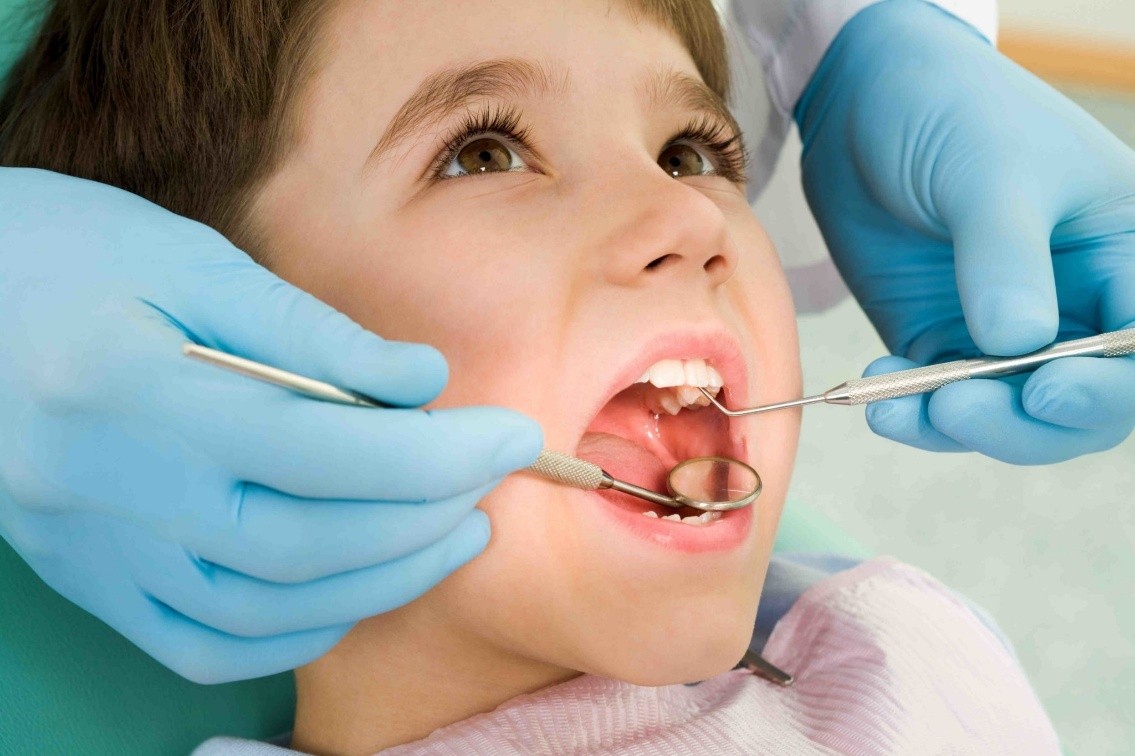- Early Beginnings: Infant Oral Care
Your child’s oral health journey begins before the first tooth. Gently wipe baby gums with a soft, damp cloth after feedings to remove sugar-causing bacteria. Once teeth emerge (typically 4–7 months), brush twice daily using a small, soft-bristled brush and a rice-grain smear of fluoride toothpaste—this helps build enamel strength early. Sugary drinks, including juice, should be avoided under age one; after 12 months, offer water between meals and snacks of crunchy fruits, vegetables, cheese, or yogurt instead.
- Toddler Years: Establishing Healthy Routines
By age 2–3, move to a pea-sized smear of fluoride toothpaste and brush twice daily for two minutes. Begin flossing as soon as teeth touch. Reinforce consistent oral care, brushing in gentle circular motions and coaching kids to spit—without rinsing immediately—to maximize fluoride’s enamel protection. Talk to your pediatric dentist about the first dental visit by age one or when teeth erupt, setting the tone for regular care and early problem detection.
- Childhood Habits & Prevention
Once children can brush independently (usually around age 6–7), continue guiding them until habits are established. Offer fun toothbrushes and flavors to boost enthusiasm. Adopt a balanced diet—blend fruits, vegetables, dairy, nuts, and water, and limit sugary or sticky snacks—to combat cavity-causing bacteria. For active kids, use custom mouthguards to prevent injury during sports.
- Sealants & Fluoride: Science-Backed Shielding
Sealants and fluoride varnishes are essential protective treatments. Dental sealants create a barrier on molars to intercept gum-damaging bacteria—effectively preventing up to 80% of cavities in chewing surfaces. Fluoride varnish strengthens enamel and reduces cavity risk by about one-third in baby teeth. Using both together offers superior protection—studies show tooth decay reduction of up to 14% more compared to fluoride alone. Additionally, silver diamine fluoride (SDF) is a minimally invasive, cost-effective option in settings with limited dental access.
- Braces & Orthodontic Care
Once your child enters orthodontic care, their oral routine needs adaptation. Brush after every meal using soft brushes angled at 45° around brackets and wires, and floss daily using orthodontic flossers or threaders. Rinse with fluoride mouthwash nightly to strengthen enamel and thwart white spot lesions. Avoid hard, sticky foods to protect braces, and use orthodontic wax to prevent irritation—plus, always use mouthguards during sports .
- Parenting as a Role Model
Kids copy their parents—be a brushing hero! Brush and floss together as a family, making it fun and reinforcing good habits. Avoid sharing utensils or toothbrushes to limit bacterial transfer. Supervise and gradually step back as their skills improve, around age 6–7.
- Regular Dental Visits & Prophylaxis
Schedule check-ups every six months—or every 3–6 months for high-risk kids—for professional cleanings, fluoride, sealants, and monitoring of growth and alignment. These preventative visits support long-term oral health, reduce risk of cavities and gum disease, and foster comfort in a dental setting.
Summary Table
| Stage | Key Focus |
| Infancy | Gum wiping, first brushing & rice-sized fluoride smear |
| Toddlers | Two-minute brushing, flossing, balanced snacks |
| Childhood | Healthy habits, diet, mouthguards |
| Sealants & Fluoride | Using sealants + varnish/SDF for extra protection |
| Orthodontics | Brackets-specific brushing, waxing, diet adaptions |
| Parental Role | Family brushing, modeling, supervision |
| Dental Visits | Regular cleanings & preventative care every 3–6 months |

